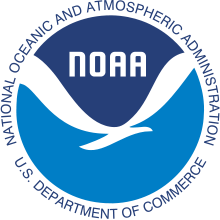Earth System Research Laboratory

The Earth System Research Laboratory (ESRL) is a laboratory in National Oceanic and Atmospheric Administration's (NOAA) Office of Oceanic and Atmospheric Research (OAR). It is one of seven NOAA Research Laboratories (RLs) and is located in Boulder, Colorado.[1]
ESRL combines six separate NOAA labs under one organization with four Divisions - Global Monitoring, Physical Sciences, Chemical Sciences, and Global Systems. The former labs falling into ESRL are the Aeronomy Laboratory, the Climate Diagnostics Center, the Climate Monitoring and Diagnostics Laboratory, the Environmental Technology Laboratory, the Forecast Systems Laboratory, and the Surface Radiation Research Branch of the Air Resources Laboratory.
Divisions
The goal of the Global Monitoring Division (GMD) is to conduct long-term, continuous measurement of atmospheric gases, particles and radiation in order to understand climate forcing, ozone depletion and air quality. This information will be used to support global and regional decisions, climate projections and carbon management.
The Physical Sciences Division (PSD) conducts research to understand the physical environment: the atmosphere, ocean, cryosphere, and land in order to improve local to global weather and climate predictions.
The Chemical Sciences Division (CSD) studies chemical processes in the Earth's atmosphere that affect climate, air quality, and the ozone layer.
The Global Systems Division (GSD) conducts research and development to provide global environmental information and forecast services ranging from short-term weather predictions to longer-term climate forecasts.
References
- ↑ "NOAA Research Laboratories". NOAA Office of Oceanic and Atmospheric Research. Retrieved 2014-04-26.
- ^ "The NOAA Earth System Research Laboratory". Retrieved October 10, 2005.
- ^ "About the Earth System Research Laboratory". Retrieved October 10, 2005.
- ^ "Global Monitoring Division". Retrieved October 10, 2005.
- ^ "Physical Sciences Division". Retrieved October 10, 2005.
- ^ "Chemical Sciences Division". Retrieved October 10, 2005.
- ^ "Global Systems Division". Retrieved October 10, 2005.